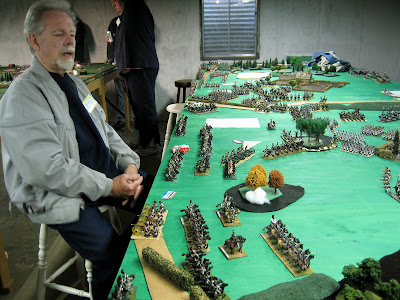
The master teaches the French a lesson in combined arms attacks.

Cavalry, artillery and infantry all threaten the French square next to the woods.
Soldiers! I give you yet another example of the master's use of combined arms in his attack. Again, we have the French infantry formed in square due to the presence of his cavalry. We also see a battery of artillery that is close enough to decimate the square. Coming up behind the artillery, we can see the arrival of his infantry. His battalions in the enclosure will soon march forth and finish off the square with musketry, if his artillery does not do the job first.

A doomed artillery battery.
Soldiers! Take a look at this picture and observe a fatal error. The Emperor's Beautiful Daughters (artillery) have their flank exposed to the Russian dragoons (see the picture at the top of this page - the squadron of Russian dragoons at the bottom of the picture will have a clear charge into the flank of the battery). Why? Because we did not keep any cavalry on hand to screen the front of our guns until they could deploy. If the guns must be posted out in the open, then they must be anchored on a terrain feature such as woods or buildings, or in the absence of that, then post a battalion of infantry in square on each flank of the artillery.
This battery will certainly be lost at the beginning of the next turn. This will trigger morale checks by all infantry within 12" of the fleeing gunners. Each morale check will have a -1 for each friendly rout seen on that turn. If a second unit routs as a result, then all remaining battalions will thus have a -2 for having seen two routs. And so on and so forth. All infantry in the vicinity of this battery must form square as this will add a +1 or +2 to morale and thus negate the effect of seeing the rout.
Your Emperor can always find cavalry. He can not obtain any more artillery. Artillery is sacred in this game and it must not be lost. Use up your cavalry, no matter how hopeless it may appear. One single squadron of cavalry must attack and at the very least, the opponent will get a "Return to Own Lines" result. Your Emperor was most distressed to see fresh squadrons of cavalry voluntarily retiring behind the infantry squares. You might even get lucky and find that your single squadron wins the melee, routs the opponent and rallies or pursues like Davout's cavalry did on the left flank on the last turn.
Lessons have been learned. A successful general learns from his mistakes and he copies the successes of his opponents. Your Emperor has confidence that we will all do better tomorrow. Think about what you can do to put the pressure on Uncle Duke and Kurt (British).
Artillery Resupply
The rules provide for ammo resupply via the simple expedient of the gun battery doing nothing for two consecutive turns. Doing that replenishes all of your original ammo. So when a gun runs out of ammo and it is at risk, it shoud be retired to safety.
Horse Artillery
In these rules, horse artillery is an offensive weapon and makes for a lousy defensive weapon. Its rapid movement allows it to move up close to infantry and fire at them with cannister. If it hasn't moved, it can double fire. Randy, your two horse batteries should be used to support an attack. Move them up with cavalry support and hose down the British, then follow up with an infantry attack of 4 to 6 battalions. The infantry can finish off the weakened opponent.
Our Going On the Defensive Strategy???
Our center and right are on the back table. There is no more space for retreat. We must not give up any ground from now on. I see that the British are advancing in a timid and somewhat reckless fashion. It is time to smite them now that they are over the hedges and walls and out in the open.

The British are now out in the open. This advance looks to be done in piecemeal fashion. Do we have any cavalry nearby, or horse artillery?

These fellows look a little bit vulnerable as well.

























